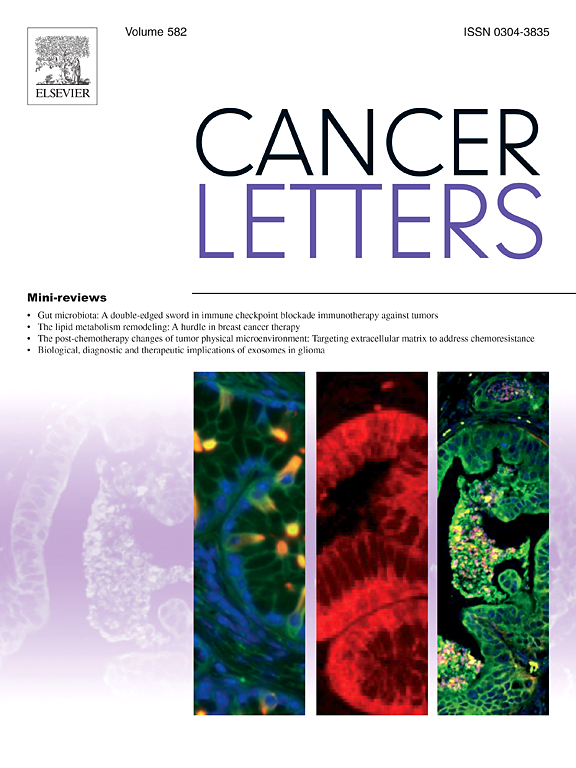MHC class I upregulation contributes to the therapeutic response to radiotherapy in combination with anti-PD-L1/anti-TGF-β in squamous cell carcinomas with enhanced CD8 T cell memory-driven response
IF 10.1
1区 医学
Q1 ONCOLOGY
引用次数: 0
Abstract
Radiation therapy (RT), a mainstay treatment for head and neck squamous cell carcinoma (HNSCC), kills cancer cells and modulates the tumor immune microenvironment. We sought to assess the effect of RT in combination with PD-L1/TGF-β dual blockade in squamous cell carcinomas (SCC) and analyze the underlying mechanisms. We transplanted mouse SCC cells derived from keratin-15 (K15) stem cells harboring KrasG12D/Smad4−/− mutations into syngeneic recipients and irradiated tumors followed by PD-L1/TGF-β dual blockade. We identified a responder line and a non-responder line to this combination therapy. Responder hosts eradicated SCCs by the combined therapy and rejected re-transplanted SCC cells 6 months post tumor eradication, which correlated with clonotype expansions of splenic CD8 T cells and effector memory gene expression identified by single cell sequencing of TCR and transcriptomes, respectively. Mechanistically, RT upregulated MHC-I (major histocompatibility complex I) and its transcriptional regulators including NLRC5, in SCCs of the responders but not non-responders. These data are consistent with the TCGA HNSCC database in which NLRC5 correlated to MHC-I genes and CD8 T cell gene expression. Functional contribution of MHC-I to PD-L1/TGF-β blockade response was confirmed by knocking out beta-2-microglobulin in responder cells that attenuated the response to the same therapy. Thus, the therapeutic effectiveness appeared to largely depend on cancer-cell MHC-I expression, triggering CD8 T cell effector memory-driven responses against tumor cell antigens. Identifying the differential RT response to MHC-I induction may serve as a predictive marker for stratifying patients that are most likely to benefit from this combination therapy.
MHC I类上调有助于鳞状细胞癌放疗联合抗PD-L1/抗TGF-β的治疗反应,CD8 T细胞记忆驱动反应增强。
放射治疗(RT)是头颈部鳞状细胞癌(HNSCC)的主要治疗方法,它能杀死癌细胞并调节肿瘤免疫微环境。我们试图评估鳞状细胞癌(SCC)中 RT 与 PD-L1/TGF-β 双阻断联合治疗的效果,并分析其潜在机制。我们将来源于携带KrasG12D/Smad4-/-突变的角蛋白-15(K15)干细胞的小鼠SCC细胞移植到无血缘关系受体中,照射肿瘤后进行PD-L1/TGF-β双重阻断。我们确定了对这种联合疗法有反应和无反应的细胞系。应答者宿主通过联合疗法根除了SCC,并在肿瘤根除6个月后排斥了再移植的SCC细胞,这与脾脏CD8 T细胞克隆型扩增以及TCR和转录组单细胞测序分别确定的效应记忆基因表达相关。从机理上讲,RT上调了应答者(而非非应答者)SCC中的MHC-I(主要组织相容性复合体I)及其转录调节因子,包括NLRC5。这些数据与 TCGA HNSCC 数据库一致,其中 NLRC5 与 MHC-I 基因和 CD8 T 细胞基因表达相关。MHC-I对PD-L1/TGF-β阻断反应的功能性贡献通过敲除反应者细胞中的β-2-微球蛋白得到了证实,这种敲除可减轻对相同疗法的反应。因此,治疗效果似乎在很大程度上取决于癌细胞 MHC-I 的表达,从而引发针对肿瘤细胞抗原的 CD8 T 细胞效应记忆驱动反应。识别对 MHC-I 诱导的不同 RT 反应可作为一种预测标记,用于对最有可能从这种联合疗法中获益的患者进行分层。
本文章由计算机程序翻译,如有差异,请以英文原文为准。
求助全文
约1分钟内获得全文
求助全文
来源期刊

Cancer letters
医学-肿瘤学
CiteScore
17.70
自引率
2.10%
发文量
427
审稿时长
15 days
期刊介绍:
Cancer Letters is a reputable international journal that serves as a platform for significant and original contributions in cancer research. The journal welcomes both full-length articles and Mini Reviews in the wide-ranging field of basic and translational oncology. Furthermore, it frequently presents Special Issues that shed light on current and topical areas in cancer research.
Cancer Letters is highly interested in various fundamental aspects that can cater to a diverse readership. These areas include the molecular genetics and cell biology of cancer, radiation biology, molecular pathology, hormones and cancer, viral oncology, metastasis, and chemoprevention. The journal actively focuses on experimental therapeutics, particularly the advancement of targeted therapies for personalized cancer medicine, such as metronomic chemotherapy.
By publishing groundbreaking research and promoting advancements in cancer treatments, Cancer Letters aims to actively contribute to the fight against cancer and the improvement of patient outcomes.
 求助内容:
求助内容: 应助结果提醒方式:
应助结果提醒方式:


